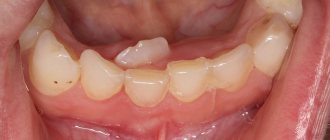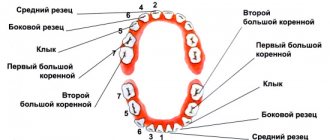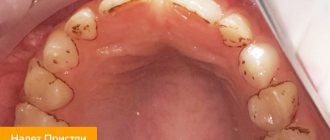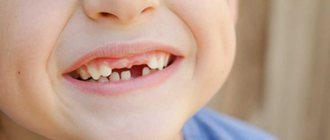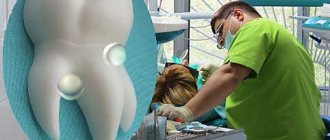What to do if teeth do not erupt “on time”?
Nothing to do. As stated earlier, the timing is quite relative and not strict data. There is such a thing as the individual characteristics of a child. Plus neonatal indicators, physical constitution, etc. Thus, the timing of the appearance of teeth in your child is normal for him. The same applies to permanent teeth.
The later the teeth appear, the healthier they will be?
Is not a fact. The timing of teething does not affect their “quality”.
What sedatives can be used during teething? Do they influence the process itself?
No, such drugs do not affect the process of teeth formation and, as a rule, have no side effects. For children with allergies, there is a sedative called Doctor Baby that does not contain lidocaine. Almost all gels contain lidocaine and inert fillers (cooling menthol, astringents and flavoring additives). You can use Dentinox, Kalgel (be careful with diathesis, because it is sweet), Kamistad (very effective, but you need to know when to stop), Mundizal, Cholisal, Solcoseryl dental paste (especially good in the presence of wounds or ulcers).
How often should such drugs be used?
Soothing gels are not antibiotics and do not need to be used according to a specific regimen. If the child is in pain, apply it, but if everything is calm, don’t. But it’s better not to use it more than 3-4 times a day and for longer than 3 days in a row.
How to help your child
The main question is, if a child has bad baby teeth, what should parents do? There are some ways to improve a bad situation. These include the following rules:
- reduce carbohydrate intake if possible;
- do not lick the pacifier or sugar it, especially before bedtime;
- From an early age, accustom your child to brushing his teeth;
- if artificial feeding, use only adaptive formulas after consulting a pediatrician;
- wipe teeth with a swab after feeding;
- Rinse your mouth after every meal as soon as your child is able to do so.
But there is also a main factor that will help cope with bad baby teeth. Of course, this is a visit to the pediatric dentist. The sooner the doctor diagnoses and treats carious teeth, the more likely it is that the baby will grow up healthy and strong. After all, the functioning of the entire child’s body depends on proper digestion. Since dangerous bacteria accumulate in carious cavities, complete tooth destruction cannot be prevented except with the help of an experienced dentist.
Is it possible to speed up teething?
Medication - no. But massaging your gums won't hurt at all. Using a clean finger, gently and gently massage your baby's gums. The baby will feel better, and the tooth will cut through faster. Just do not press hard so as not to injure the gums. You can give your child a cool spoon or pacifier to hold in his mouth. Try buying special teethers with liquid. They are placed in the refrigerator for a while, and then given to the child to chew on. All these methods are good in moderation, do not overdo it.
Can bad breath occur during teething and what is the cause?
The process of teething is associated with partial decomposition (lysis) of the mucous membrane under the action of salivary enzymes. We all notice that the amount of saliva increases sharply during this period. In this case, indeed, indicators such as viscosity, color and smell of saliva may change. Another factor is the presence of weak antibacterial substances in saliva, which are designed to prevent infection of the wound when a tooth cuts through the gum. A certain amount of blood also enters the oral cavity. When it decomposes, a sour (metallic) odor may appear.
A sharp increase in temperature during teething. What to do?
Teething does not cause a temperature jump to 39-40 degrees. Only a slight increase is possible, which is normal. Be careful: teething should not cause high fever, diarrhea, vomiting, complete loss of appetite, cramps or choking. If you have such symptoms, even if you attribute it to your teeth, consult a doctor. It is also not recommended to use antipyretics and painkillers without consulting him.
What is the difference between an increase in temperature due to teething and an increase due to other reasons? How long can the elevated temperature last in the first case?
It all depends on the individual characteristics of the child. Basically, hyperthermia and diarrhea are only secondary signs of the teething process, which in itself is a serious physiological turning point for a small organism. Fever is, rather, a reaction to inflammation of the oral mucosa. After all, at the site where the tooth exits, irritation forms, often a wound that can become infected. Thus, hyperthermia is caused not by the mechanism of tooth formation itself, but by side effects. After all, the eruption of permanent teeth, despite the similarity of histological and physiological changes, causes symptoms of colds and diarrhea extremely rarely. And it is quite simple to explain their appearance in children: changes in diet and diet, constant foreign objects in the mouth, microflora disturbance, weakened immunity in the nasopharynx. So, if high fever and loose stools continue for more than 72 hours, then teething really has nothing to do with it.
Specifics of the appearance of milk jugs
The eruption of milk ducts in children is a complex and deep mechanism inherent in genes, and preparation for this event is carried out in the child’s body almost from the moment of its birth in the mother’s womb. It is reliably known that baby teeth begin to form in the baby’s gums already in the second month of his life, and therefore any deviations already at this stage can play a negative role in the future.
Dairy teeth begin to erupt, on average, at the age of six months, although the first signs of the appearance of future teeth are sometimes noted as early as the fourth month after birth (in the form of small tubercles on the gums). The process of teething lasts until almost three years, and after another three years their gradual loss begins, with simultaneous replacement with permanent teeth that will remain with the person for the rest of his life.
Milk jugs begin to erupt, on average, at the age of six months.
The life cycle of milk jugs is a very important and integral part of the formation of a child, therefore any deviation in the order determined by genes can lead to negative consequences that can affect other areas of the child’s body.
Doctors more often encounter children with premature loss of baby teeth, but from time to time the opposite situations arise when milkmen, for some reason, are in no hurry to teethe. In order to be able to objectively assess possible irregularities in the appearance of milk jugs, you need to check the long-established, well-known formula that describes this process:
- central incisors appear at 6–10 (bottom) and 8–12 (top) months;
- lateral incisors appear at 10–16 (bottom) and 9–13 (top) months;
- fangs appear at 17–23 (bottom) and 16–22 (top) months;
- premolars appear at 14–18 (bottom) and 13–19 (top) months;
- molars appear at 23–31 (bottom) and 25–33 (top) months.
From this table, young parents should draw the first and most important conclusion for themselves: the spread in terms of timing is quite large, so if a child the same age as their child already has some teeth, but their baby still doesn’t, this is not necessarily a reason to panic. All children are individual, as well as their genes and living conditions, therefore only a pediatrician can draw any serious conclusions about the delay in the appearance of milk jugs.
Important! Teething is directly related to daily hormonal fluctuations in the child’s body, and the most active growth of teeth is observed from 20 pm to 1 am.
Teething in infants
Possible characteristics of teeth in children at the teething stage. Stay up to date.
The expansion of the spaces between the teeth is caused by the growth of the jaws. During the transition from baby teeth to permanent teeth, it is considered a normal condition. A wide gap between the upper anterior incisors is usually associated with a deep-lying maxillary frenulum. An orthodontist should observe and treat such a gap between the teeth;
- a blackish edging on the neck of the tooth can form when taking soluble iron supplements, as well as during a chronic inflammatory process (precipitation of bacteria from the leptotrichium group);
- yellowish-brown staining of teeth may be associated with the use of antibiotics - by the mother in the 2nd half of pregnancy or by the child himself during the formation of teeth;
- yellowish-greenish coloring is caused by severe disturbances in bilirubin metabolism, hemolytic conditions (destruction of red blood cells);
- reddish staining of tooth enamel is characteristic of a disease called porphyria - a congenital disorder of the metabolism of porphyrin pigment;
- malocclusions are formed by the uneven growth of the child’s jaws, as well as prolonged sucking of the nipples;
- Anomalies in the location of teeth occur for a number of reasons: trauma, congenital disorders of connective tissue metabolism, constitutional reasons (small jaw size), tumors of the alveolar process of the jaw.
- the absence of teeth before one year of age is extremely rarely associated with edentia (lack of tooth buds), which can be checked using radiovisiography as prescribed by a pediatric dentist.
If teeth erupt on time and in a certain order, this indicates the normal development of the child’s body. After all, this physiological process is in direct connection with the general health of the baby. Some atypical cases may indirectly indicate the presence of pathology. But only a special examination of the child can confirm or refute the assumptions made. The reasons must be identified and analyzed by a specialist.
The main causes of decay of baby teeth
There are two age peaks when enamel damage is most intense. This is the early childhood period, when drinking a bottle is still relevant, as well as reaching 4-5 years of age. The reasons leading to bad baby teeth are practically the same.
The main factors contributing to the destruction of enamel can be represented as follows:
- hereditary predisposition;
- previous cold infections during the first trimester of pregnancy;
- excess carbohydrates in food;
- the baby’s habit of drinking sweets from a bottle before bed;
- poor oral hygiene;
- lack of calcium ions in the diet;
- weak immunity – frequent colds.
In children under 2-3 years of age, the front teeth more often deteriorate, and then in the older period - all the rest. Initially, this is due to the fact that it is the carbohydrate residues that settle after using the bottle that destroy the enamel of baby teeth.
Is late tooth growth dangerous?
If baby teeth do not grow, then in general this does not pose a danger, but it cannot be done without the intervention of a doctor. The specialist must conduct a preventive examination, talk with the parents, determining their teething characteristics, and then determine whether there is a reason for concern or not. Studies have shown that if the cause is heredity, then problems with permanent teeth are possible in the future.
What causes late eruption:
- health problems with the mother during pregnancy (for example, severe toxicosis);
- various diseases.
Incorrect placement of primary teeth affects the location of permanent teeth.
What do the deadlines depend on?
When determining why a child’s teeth do not grow, you need to take into account the following factors:
- the formation process depends on gender, girls develop teeth earlier than boys;
- The baby's growth also affects teething. So, if the baby is not tall, then teething will begin later;
- upper and lower jaws. At what stage does teething occur earlier? On the bottom.
A child’s bite has two stages – temporary and permanent. If it is temporary, then teething occurs less frequently. The location of the teeth also matters, for example, the second and third molars emerge later than the others. It is influenced by development and climate, place of residence, heredity - when the parents began to teethe, their children will begin to do so at about the same age.


